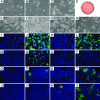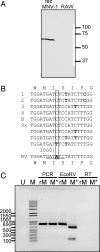Recovery of infectious murine norovirus using pol II-driven expression of full-length cDNA
- PMID: 17581883
- PMCID: PMC1904157
- DOI: 10.1073/pnas.0700336104
Recovery of infectious murine norovirus using pol II-driven expression of full-length cDNA
Abstract
Noroviruses are the major cause of nonbacterial gastroenteritis in humans. These viruses have remained refractory to detailed molecular studies because of the lack of a reverse genetics system coupled to a permissive cell line for targeted genetic manipulation. There is no permissive cell line in which to grow infectious human noroviruses nor an authentic animal model that supports their replication. In contrast, murine norovirus (MNV) offers a tractable system for the study of noroviruses with the recent discovery of permissive cells and a mouse model. The lack of a reverse genetic system for MNV has been a significant block to understanding the biology of noroviruses. We report recovery of infectious MNV after baculovirus delivery of viral cDNA to human hepatoma cells under the control of an inducible DNA polymerase (pol) II promoter. Recovered virus replicated in murine macrophage (RAW264.7) cells, and the recovery of MNV from DNA was confirmed through recovery of virus containing a marker mutation. This pol II promoter driven expression of viral cDNA also generated infectious virus after transfection of HEK293T cells, thus providing both transduction and transfection systems for norovirus reverse genetics. We used norovirus reverse genetics to demonstrate by mutagenesis of the protease-polymerase (pro-pol) cleavage site that processing of pro-pol is essential for the recovery of infectious MNV. This represents the first infectious reverse genetics system for a norovirus, and should provide approaches to address fundamental questions in norovirus molecular biology and replication.
Conflict of interest statement
The authors declare no conflict of interest.
Figures



Similar articles
-
Reverse genetics mediated recovery of infectious murine norovirus.J Vis Exp. 2012 Jun 24;(64):4145. doi: 10.3791/4145. J Vis Exp. 2012. PMID: 22760450 Free PMC article.
-
Murine norovirus: propagation, quantification, and genetic manipulation.Curr Protoc Microbiol. 2014 May 1;33:15K.2.1-61. doi: 10.1002/9780471729259.mc15k02s33. Curr Protoc Microbiol. 2014. PMID: 24789596 Free PMC article.
-
Single-cell transcriptional analysis of murine norovirus infection in a human intestinal cell line.J Virol. 2024 Nov 19;98(11):e0161724. doi: 10.1128/jvi.01617-24. Epub 2024 Oct 30. J Virol. 2024. PMID: 39475272
-
Murine norovirus, a recently discovered and highly prevalent viral agent of mice.Lab Anim (NY). 2008 Jul;37(7):314-20. doi: 10.1038/laban0708-314. Lab Anim (NY). 2008. PMID: 18568010 Review.
-
Molecular and Genetics-Based Systems for Tracing the Evolution and Exploring the Mechanisms of Human Norovirus Infections.Int J Mol Sci. 2023 May 22;24(10):9093. doi: 10.3390/ijms24109093. Int J Mol Sci. 2023. PMID: 37240438 Free PMC article. Review.
Cited by
-
Endocytosis of murine norovirus 1 into murine macrophages is dependent on dynamin II and cholesterol.J Virol. 2010 Jun;84(12):6163-76. doi: 10.1128/JVI.00331-10. Epub 2010 Apr 7. J Virol. 2010. PMID: 20375172 Free PMC article.
-
Norovirus Attachment and Entry.Viruses. 2019 May 30;11(6):495. doi: 10.3390/v11060495. Viruses. 2019. PMID: 31151248 Free PMC article. Review.
-
Positive strand RNA viruses differ in the constraints they place on the folding of their negative strand.RNA. 2022 Oct;28(10):1359-1376. doi: 10.1261/rna.079125.122. Epub 2022 Aug 2. RNA. 2022. PMID: 35918125 Free PMC article.
-
Reverse genetics mediated recovery of infectious murine norovirus.J Vis Exp. 2012 Jun 24;(64):4145. doi: 10.3791/4145. J Vis Exp. 2012. PMID: 22760450 Free PMC article.
-
Antiviral activity of a small molecule deubiquitinase inhibitor occurs via induction of the unfolded protein response.PLoS Pathog. 2012;8(7):e1002783. doi: 10.1371/journal.ppat.1002783. Epub 2012 Jul 5. PLoS Pathog. 2012. PMID: 22792064 Free PMC article.
References
-
- Clarke IN, Lambden PR. In: Topley and Wilson's Microbiology and Microbial Infections: Virology. Mahy BWJ, ter Meulen W, editors. Vol 2. London: Hodder Arnold; 2005. pp. 911–931.
-
- Fankhauser RL, Noel JS, Monroe SS, Ando T, Glass RIM. J Infect Dis. 1998;178:1571–1578. - PubMed
-
- Green KY, Chanock RM, Kapikian AZ. In: Fields Virology. Knipe DM, Howley PM, editors. Philadelphia: Lippincott Williams & Wilkins; 2001. pp. 841–874.
Publication types
MeSH terms
Substances
Grants and funding
LinkOut - more resources
Full Text Sources
Medical

